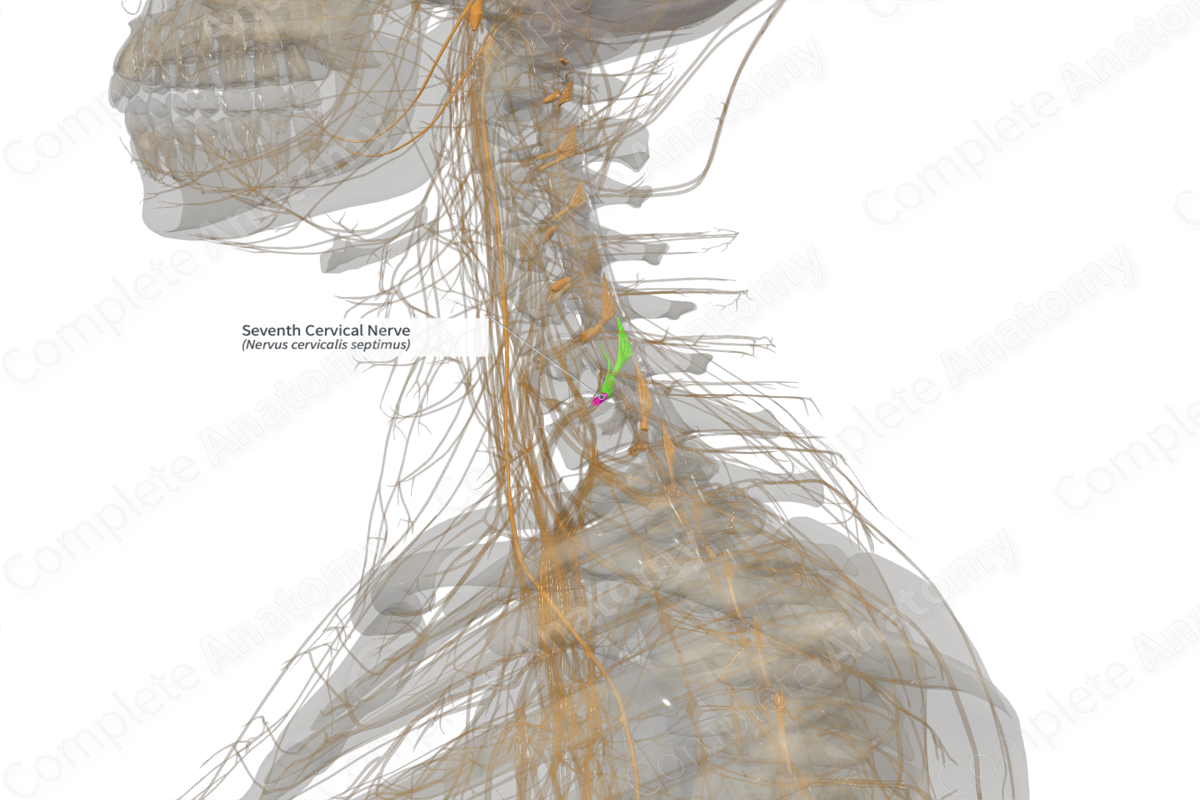
Quick Facts
Origin: Formed by the union of anterior and posterior roots emerging from the C7 spinal cord segment.
Course: Travels laterally for a short distance to the bifurcation of anterior and posterior rami.
Branches: Anterior and posterior rami.
Supply: Motor innervation to the muscles of the upper limb, shoulder, and back. Sensory innervation to the skin above trapezius and to posterior part of the upper limb.
Origin
The seventh cervical nerve is a mixed nerve, formed by the union of its posterior nerve root (sensory nerve fibers) with its anterior nerve root (motor nerve fibers). The roots emerge from the posterolateral and anterolateral sulci of the C7 spinal segment and unite to form the seventh cervical nerve.
Course
The seventh cervical nerve exits the vertebral column by traveling through the intervertebral foramen situated between the sixth and seventh cervical vertebrae. It travels laterally a short distance and bifurcates into anterior and posterior rami.
Branches
The seventh cervical nerve divides into posterior (dorsal) and anterior (ventral) rami, both of which receive sensory and motor fibers.
The anterior ramus of the seventh cervical nerve passes anteriorly and contributes to the formation of the brachial plexus (along with the anterior rami of the fifth to eighth cervical and first thoracic nerves).
The posterior ramus winds posteriorly around the C7 articular pillar and divides into medial and lateral branches.
Supplied Structures
The anterior ramus of the seventh cervical nerve conveys motor fibers to the middle trunk of the brachial plexus. Fibers that enter the lateral cord of the brachial plexus help innervate muscles of the anterior compartment of the arm (coracobrachialis and lateral part of brachialis), pectoralis major, pronator teres, flexor carpi radialis, palmaris longus, flexor carpi ulnaris, flexor pollicis longus, and pronator quadratus. Fibers that enter the posterior cord provide motor innervation to the subscapularis, teres major, latissimus dorsi, triceps, anconeus, extensor carpi radialis longus, supinator, extensor carpi radialis brevis, extensor digitorum, and extensor digiti minimi, extensor carpi ulnaris, abductor pollicis longus, extensor pollicis brevis, extensor pollicis longus, and extensor indicis.
Some sensory fibers from the skin around the second and third fingers and the posterior aspect of the upper limb also travel via the anterior ramus of the seventh cervical nerve.
The lateral branch of the dorsal ramus provides motor somatic innervation to the longissimus colli, splenius colli, and iliocostalis colli muscles. Those which pass through the medial branch provide motor innervation to multifidus, semispinalis colli, semispinalis capitis, splenius colli, and trapezius, before becoming cutaneous.
The sensory afferent neurons, which provide innervation to the skin above the trapezius, transmit general sensory information regarding pain, touch, pressure, vibration, etc. via the medial branch of the dorsal ramus.
Learn more about this topic from other Elsevier products




